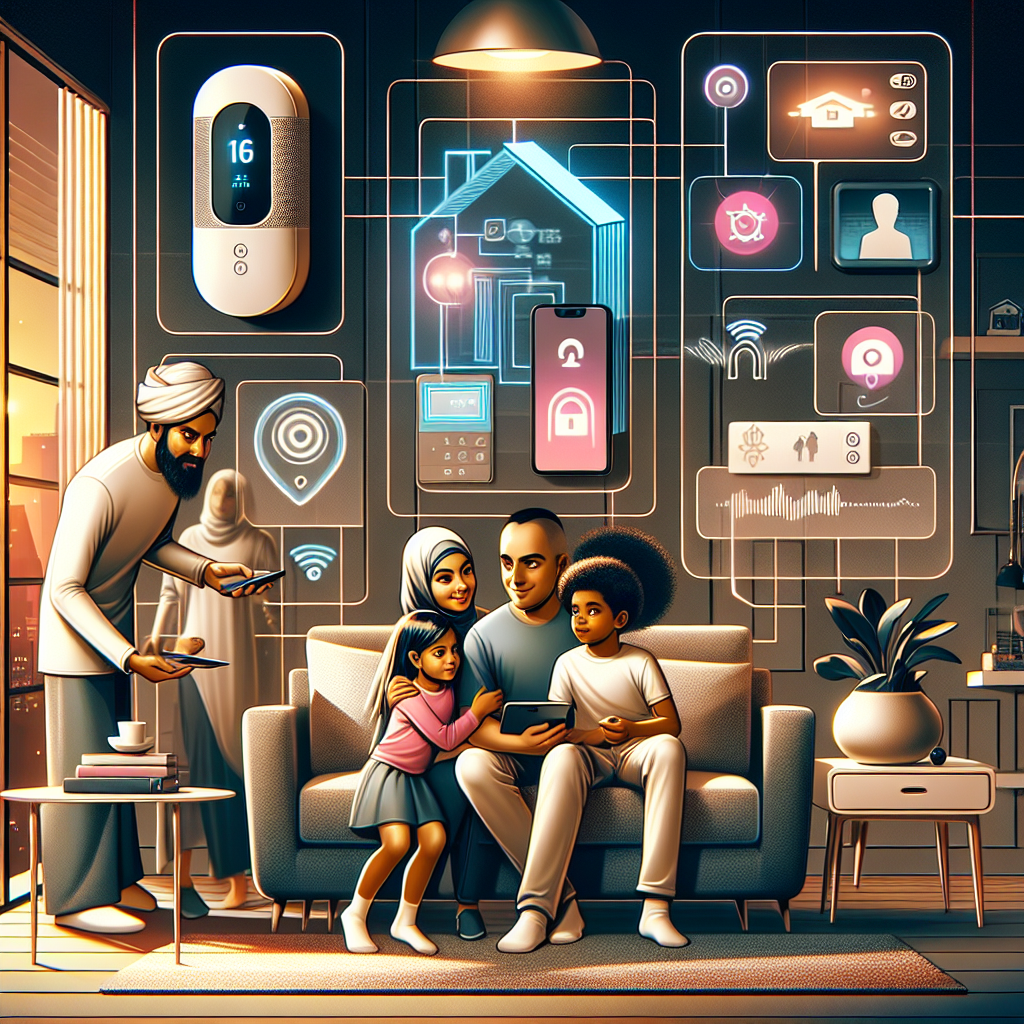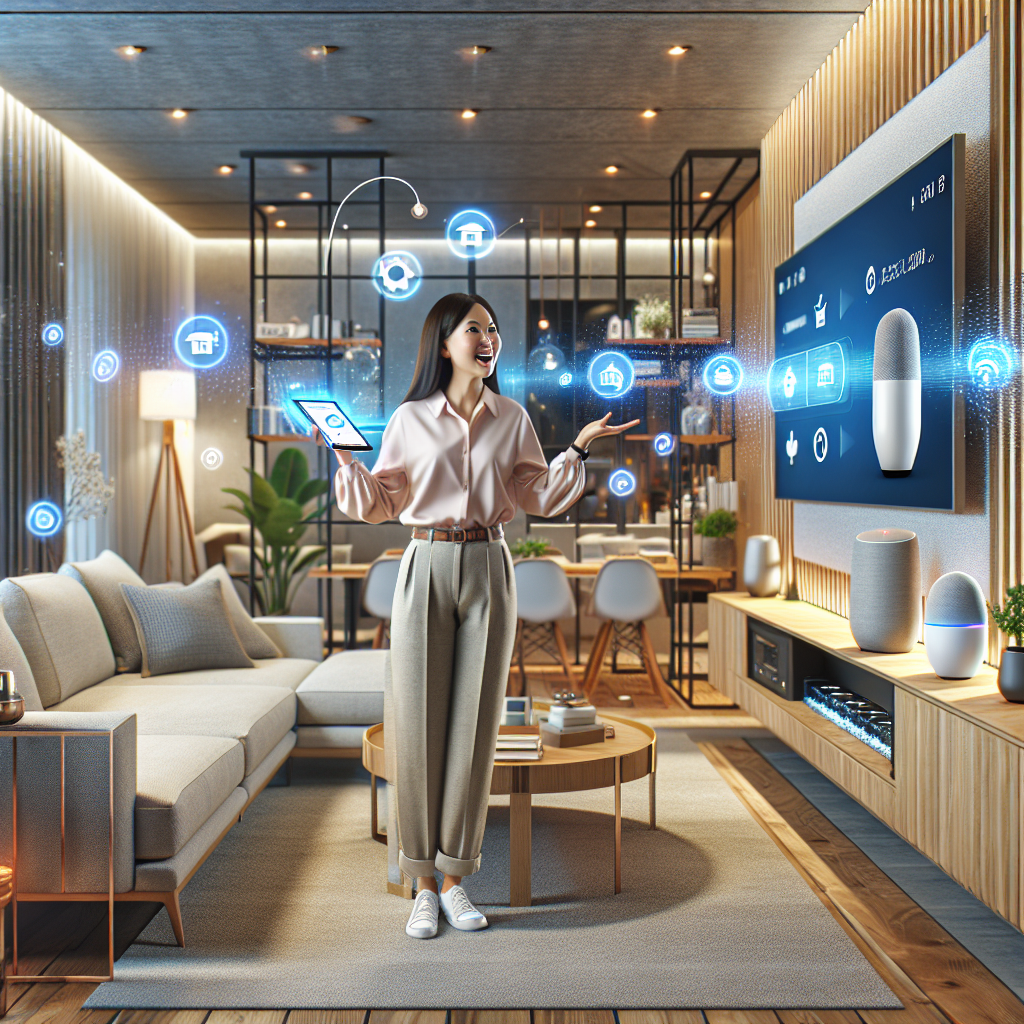In the rapidly evolving world of technology, Smart Home Integration with Voice Assistants has taken the center stage as the future of home automation. Voice assistants such as Amazon’s Alexa, Google Assistant, and Apple’s Siri are revolutionizing the way we interact with our homes, making everyday tasks easier and more convenient. From controlling lights and temperature to playing music and setting reminders, these intelligent voice-operated devices offer a seamless and futuristic experience. Join us on a journey as we explore the endless possibilities and potential of Smart Home Integration with Voice Assistants, and delve into the compelling ways in which they are reshaping our homes and lifestyles.
Understanding Smart Home Integration
In the realm of modern living, Smart Home Integration refers to the seamless connectivity and control of various devices and systems within a household through a central hub or platform. This integration allows for the automation and coordination of different functions such as lighting, heating, security, entertainment systems, and more, all under one unified system. Utilizing advanced technologies like sensors, actuators, and Internet of Things (IoT) devices, smart home integration aims to enhance convenience, efficiency, and security for homeowners.
Definition of Smart Home Integration
Smart Home Integration involves the interconnection and synchronization of different smart devices and systems to work together harmoniously within a household. This integration enables users to remotely monitor and manage their home environment through a centralized control interface, often accessible through smartphones, tablets, or voice assistants.
Importance of Smart Home Integration in Modern Living
The significance of Smart Home Integration in contemporary living lies in its ability to streamline daily tasks, enhance energy efficiency, and provide a heightened level of comfort and security for homeowners. By enabling devices to communicate with each other and respond to preset commands or triggers, smart home integration simplifies routine activities and creates a more personalized and adaptive living space.
Brief Overview of Voice Assistants in Smart Home Systems
Voice assistants play a pivotal role in smart home integration by serving as the primary interface through which users can interact with and command various connected devices. These intelligent virtual assistants, powered by artificial intelligence (AI) algorithms, can understand natural language commands and execute tasks such as adjusting settings, playing music, providing information, and controlling smart home devices—all through voice commands. As voice recognition technology continues to advance, voice assistants are becoming increasingly integral to the seamless operation and user experience of smart home systems.
Evolution of Voice Assistants in Smart Home Systems
Early Voice Assistant Technologies
In the early stages of smart home integration, voice assistants were rudimentary and limited in functionality. These early voice assistants primarily focused on basic tasks such as setting reminders, playing music, and providing simple information. The user experience was often clunky, with limited voice recognition capabilities and a narrow range of compatible devices. Examples of early voice assistants include systems like Apple’s Siri and Microsoft’s Cortana, which laid the foundation for more advanced technologies to come.
Advancements in Voice Recognition and AI
As technology progressed, voice assistants underwent significant advancements in voice recognition and artificial intelligence (AI). These improvements enabled voice assistants to better understand natural language commands, recognize different voices within a household, and provide more personalized responses. Machine learning algorithms played a crucial role in enhancing the accuracy and efficiency of voice recognition systems, allowing for smoother interactions between users and their smart home devices.
Integration of Voice Assistants with Smart Home Devices
One of the key developments in the evolution of voice assistants has been their seamless integration with a wide range of smart home devices. Modern voice assistants, such as Amazon’s Alexa and Google Assistant, can now control not only individual smart devices but entire smart home systems. Users can now use voice commands to adjust lighting, set thermostats, lock doors, and even monitor security cameras, all through a single voice assistant platform. This level of integration has transformed the way users interact with their smart homes, making the experience more intuitive, convenient, and interconnected.
Smart Home Integration with Voice Assistants offers enhanced convenience, efficiency, and security for homeowners by allowing seamless connectivity and control of various devices within a household. Voice assistants play a pivotal role in simplifying routine activities, enhancing user experience, and creating a more personalized and adaptive living space. As technology continues to advance, voice assistants are expected to offer more sophisticated capabilities, interoperability among different platforms, and integration with artificial intelligence, shaping the future of smart home systems.
Benefits of Voice Assistants in Smart Homes
Evolution of Voice Assistants in Smart Home Systems
- Hands-Free Control of Smart Devices
Voice assistants offer users the ability to control their smart home devices without the need to physically interact with them. By simply issuing voice commands, individuals can adjust lighting settings, regulate room temperatures, or even lock doors, all while they go about their daily activities. This hands-free control not only enhances convenience but also promotes accessibility for individuals with mobility issues or disabilities.
- Enhanced Convenience and Efficiency
Integrating voice assistants into smart home systems streamlines the process of managing various devices within the household. With a simple voice command, users can set up routines that automate repetitive tasks, such as turning off lights at a specific time or adjusting the thermostat when they leave the house. This level of convenience not only saves time but also reduces the cognitive load on individuals, allowing them to focus on more important aspects of their daily lives.
- Personalized User Experience
Voice assistants have the capability to learn user preferences and adapt to individual needs over time. By analyzing patterns in user behavior and interactions, these assistants can offer personalized recommendations, such as suggesting optimal lighting settings based on the time of day or adjusting the music playlist to match a user’s mood. This personalized user experience creates a more tailored and intuitive smart home environment, enhancing user satisfaction and overall quality of life.
Popular Voice Assistants for Smart Home Integration

Amazon Alexa
- Amazon Alexa is one of the leading voice assistants in the smart home integration market.
- Known for its wide range of compatible smart home devices, Alexa allows users to control various aspects of their homes using voice commands.
- Alexa’s skills enable it to perform tasks such as adjusting thermostats, turning on lights, locking doors, and even ordering groceries.
- With its constantly expanding ecosystem, Alexa continues to enhance its capabilities and integrations with third-party devices and services.
Google Assistant
- Google Assistant is another prominent voice assistant that offers seamless integration with smart home devices.
- Leveraging Google’s vast search capabilities, Assistant provides users with personalized responses and a deep understanding of context.
- Google Assistant can control a multitude of smart devices, from smart lights to security cameras, creating a connected and convenient home experience.
- Its compatibility with a wide range of products and services makes Google Assistant a popular choice for those looking to create a smart home ecosystem.
Apple Siri
- Apple’s Siri may have been one of the first mainstream voice assistants, but its integration with smart home devices has been more limited compared to Alexa and Google Assistant.
- Siri’s HomeKit platform offers a secure and private way to control smart home products, focusing on user privacy and data protection.
- While Siri may not have the same breadth of compatible devices as its competitors, it excels in offering a seamless experience for Apple users within the iOS ecosystem.
- With Apple’s focus on innovation, Siri is expected to evolve and expand its smart home integration capabilities in the future.
Comparison of Features and Capabilities
- Each of these voice assistants has its strengths and weaknesses when it comes to smart home integration.
- Amazon Alexa shines in its extensive device compatibility and skill set, making it a versatile choice for users with diverse smart home needs.
- Google Assistant stands out for its deep integration with Google services and its ability to provide contextual responses based on user behavior and preferences.
- Apple Siri prioritizes user privacy and data security, offering a seamless experience for Apple users within the HomeKit ecosystem.
- The future of smart home integration with voice assistants will likely see advancements in artificial intelligence, natural language processing, and increased interoperability among different platforms to create a more unified and intelligent smart home experience.
Compatibility and Connectivity
- Integration with Different Smart Home Devices
Voice assistants for smart home integration are continuously evolving to be compatible with a wide array of smart devices, including smart thermostats, lighting systems, security cameras, and more. Compatibility is crucial to ensure seamless communication and control between the voice assistant and various smart home gadgets. Manufacturers are actively working to expand the compatibility of voice assistants with a broader range of devices to enhance the user experience and streamline smart home management.
- Interoperability Among Voice Assistant Platforms
The future of smart home integration with voice assistants relies heavily on achieving interoperability among different voice assistant platforms. As consumers may own devices that operate on various voice assistant ecosystems, the ability for these platforms to work harmoniously together is essential. Efforts are underway to establish standards and protocols that enable interoperability, allowing users to control their smart home devices regardless of the voice assistant they are using. This interoperability enhances convenience and flexibility for users, fostering a more cohesive smart home environment.
- Challenges and Solutions in Connecting Voice Assistants to Smart Home Systems
Despite advancements in compatibility and connectivity, challenges persist in connecting voice assistants to smart home systems. One major obstacle is ensuring seamless communication between devices from different manufacturers, each with its own set of protocols and standards. To address this challenge, industry stakeholders are collaborating to develop universal communication protocols that facilitate smooth interaction between voice assistants and smart home devices. Additionally, enhancing security measures to protect user privacy and data integrity remains a critical focus in the integration of voice assistants with smart home systems. Efforts to implement robust encryption and authentication mechanisms are crucial to safeguarding sensitive information in the interconnected smart home ecosystem.

Security and Privacy Considerations
- Data Protection Concerns with Voice Commands
As smart home devices become more integrated with voice assistants, concerns about data protection and privacy arise. Voice commands are transmitted and stored by the voice assistant, raising questions about who has access to this data, how it is being used, and whether it is being adequately protected from unauthorized access. Users may worry about their sensitive information being exposed or misused, highlighting the need for robust security measures.
- Strategies for Securing Voice Assistant-Enabled Smart Homes
Securing voice assistant-enabled smart homes requires a multi-faceted approach. Manufacturers can implement end-to-end encryption to protect the transmission of data between devices and voice assistants. Additionally, regular software updates should be provided to patch vulnerabilities and enhance security features. Users can also take proactive steps such as using unique, strong passwords for their devices and enabling two-factor authentication where available to add an extra layer of protection.
- Privacy Settings and Permissions for Voice Assistants
Privacy settings and permissions play a crucial role in safeguarding sensitive information within smart homes. Voice assistants should offer granular controls that allow users to manage what data is collected, how it is stored, and who has access to it. Clear and transparent privacy policies should be provided to inform users about the data practices of the voice assistant platform. Users should be empowered to review and adjust their privacy settings regularly to align with their comfort level regarding data sharing and protection.
Future Trends in Smart Home Integration
curity and Privacy Considerations
- Voice Assistant Technology Advancements
As technology continues to evolve, voice assistant capabilities are expected to become more sophisticated and intuitive. Future voice assistants are likely to offer enhanced natural language processing, enabling more seamless interactions with smart home devices. Additionally, advancements in voice recognition technology may lead to improved accuracy and personalization, allowing voice assistants to better understand individual preferences and habits.
- Expansion of Smart Home Ecosystems
The future of smart home integration is poised to witness a significant expansion of ecosystems, with a growing number of devices and services becoming compatible with voice assistants. This trend is expected to result in increased interoperability among smart home products, offering users greater flexibility and convenience in managing their connected devices. From smart thermostats to security cameras, the integration of diverse devices within a unified ecosystem is likely to streamline the user experience and enhance overall home automation.
- Integration of Artificial Intelligence and Machine Learning in Smart Home Systems

The integration of artificial intelligence (AI) and machine learning algorithms is anticipated to play a pivotal role in shaping the future of smart home systems. By leveraging AI capabilities, smart home devices can learn from user behaviors, anticipate preferences, and automate routine tasks to optimize energy efficiency and enhance overall comfort. Moreover, machine learning algorithms can enable predictive maintenance of smart home devices, preemptively detecting and addressing potential issues before they escalate. This integration of AI and machine learning is expected to propel smart home technology towards greater autonomy and intelligence, ultimately transforming the way individuals interact with their living spaces.
User Experience and Adoption
Voice assistants have revolutionized the way users interact with smart home devices, offering a hands-free and intuitive experience that enhances convenience and efficiency. Here are some key points related to user experience and adoption:
- User Feedback and Satisfaction with Voice Assistants:
- Numerous studies have shown a high level of satisfaction among users who have integrated voice assistants into their smart homes. The ability to control various devices through simple voice commands has been particularly praised for its convenience and accessibility.
- Feedback from users often highlights the seamless integration of voice assistants with other smart home devices, creating a cohesive ecosystem that enhances the overall user experience.
-
Issues related to privacy and data security have been raised, with some users expressing concerns about the potential risks associated with having constantly listening devices in their homes.
-
Factors Influencing Adoption of Smart Home Integration:
- The ease of use and setup of voice assistants play a significant role in driving adoption rates. Devices that are user-friendly and offer a quick and hassle-free setup process are more likely to be embraced by consumers.
- The compatibility of voice assistants with existing smart home devices is another crucial factor influencing adoption. Users are more inclined to invest in voice assistants that can seamlessly integrate with a wide range of devices and platforms.
-
Marketing and education efforts also play a vital role in promoting the adoption of smart home integration with voice assistants. Clear communication about the benefits and capabilities of these technologies can help dispel any apprehensions or doubts that potential users may have.
-
Predictions for the Future of Voice Assistants in Smart Homes:
- The future of voice assistants in smart homes looks promising, with continued advancements in artificial intelligence and natural language processing enhancing the capabilities of these devices.
- Personalization and customization features are expected to become more sophisticated, allowing users to tailor their smart home experience to their specific preferences and needs.
- Integration with emerging technologies such as Internet of Things (IoT) devices, augmented reality, and virtual reality is likely to further expand the functionality and utility of voice assistants in smart homes.
FAQs: Exploring the Future of Smart Home Integration with Voice Assistants
What are voice assistants in the context of smart home integration?
Voice assistants, such as Amazon’s Alexa, Google Assistant, and Apple’s Siri, are virtual assistants that use natural language processing to respond to voice commands. In the context of smart home integration, these voice assistants can control smart devices, such as thermostats, lights, and security systems, through voice commands.
How do voice assistants improve the functionality of smart home devices?
Voice assistants make it easier and more convenient to control smart home devices. Instead of having to manually adjust settings on each device, users can simply give voice commands to the voice assistant to control multiple devices at once. This not only saves time but also allows for a more seamless and intuitive user experience.
Are voice assistants secure for use in smart home integration?
While there have been concerns about the security and privacy implications of using voice assistants in smart homes, companies are constantly working to improve these aspects. It is important for users to take precautions, such as setting up secure passwords and enabling two-factor authentication, to help protect their personal information while using voice assistants for smart home integration.
What are the potential future developments in smart home integration with voice assistants?
The future of smart home integration with voice assistants holds great potential for further innovation and convenience. We can expect to see more advanced capabilities, such as personalized responses and integration with other emerging technologies like artificial intelligence and the Internet of Things. Additionally, voice assistants may become even more integrated into our daily lives, controlling a wide range of devices and providing seamless interactions throughout our homes.